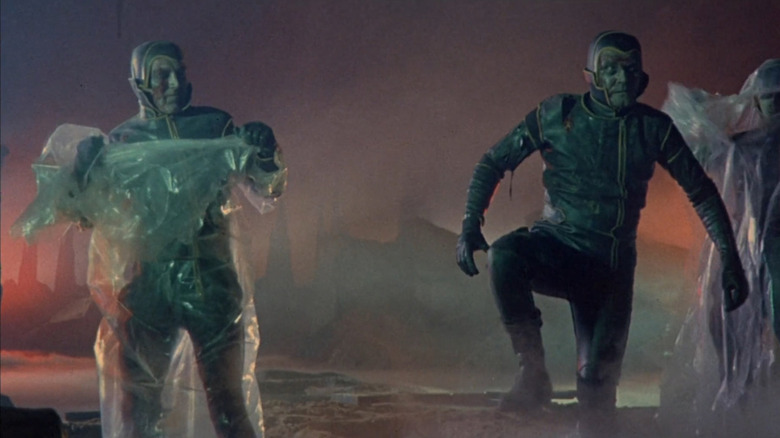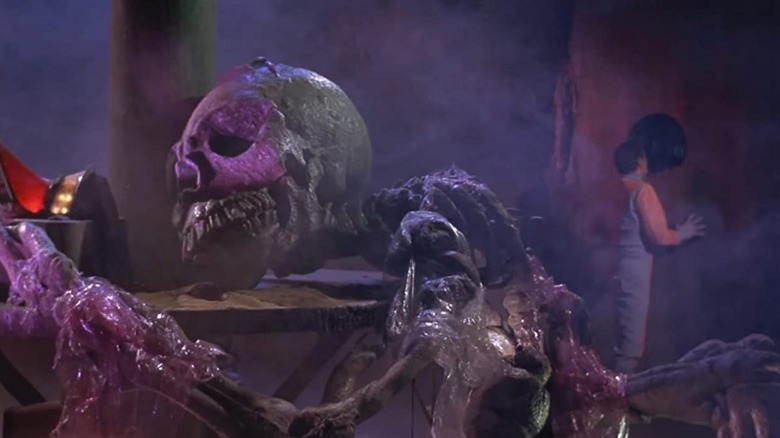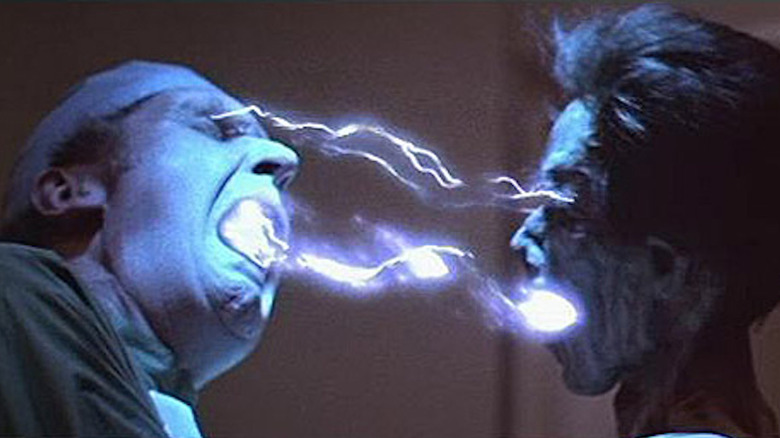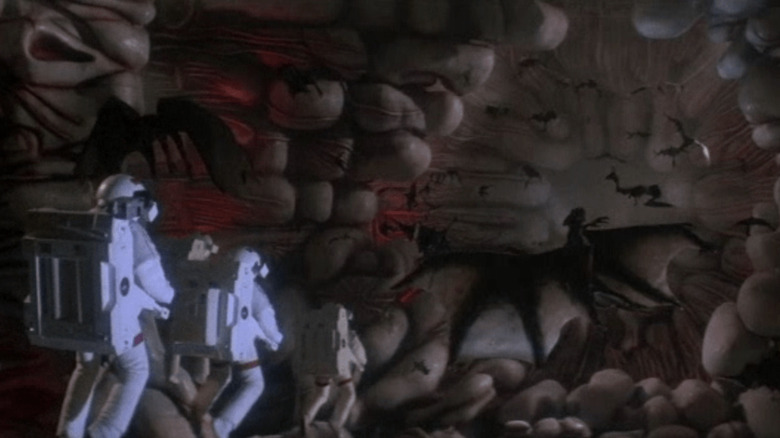Year Of The Vampire: Planet Of The Vampires And Lifeforce Took Sci-Fi Schlock To New Heights
(Welcome to Year of the Vampire, a series examining the greatest, strangest, and sometimes overlooked vampire movies of all time in honor of "Nosferatu," which turns 100 this year.)
While there are vampire films set in creepy European castles, snowy Alaskan towns, or even the mean streets of New York, very few have ventured beyond the Earth's thermosphere and into the vast darkness of space. It seems like a no-brainer if you think about it, as the isolation of traveling through the stars in a confined spacecraft seems like the perfect place for evil bloodsuckers to dwell. Exactly two decades apart, a pair of sci-fi vampire movies dared to take the menacing domain of Dracula and transpose it into the cosmos, albeit to somewhat schlocky but nonetheless charming results: Mario Bava's "Planet of the Vampires" (1965) and Tobe Hooper's "Lifeforce" (1985).
Both of these horror flicks exist in that glorious place of exploitation film nirvana where genres mash, taboos are broken, and ambition far exceeds budget. They also attempt to imbue the vampiric lore solidified in the pages of Bram Stoker with a science fiction framework that, as we will explore, manages to add striking new dimensions to a monster that had become very old hat by the time these movies hit the local grindhouses or drive-ins they were clearly made for. With "Planet of the Vampires" having just received a brand-new special edition Blu-ray release from Kino Lorber, now is a perfect time to take a look at a double feature where two genre stalwart directors made a stab at melding sci-fi and horror and wound up in the pantheon of cult excellence. This pair of creature features are what weird cinema is all about, folks.
Planet of the Vampires (1965)
By 1965, the veteran cinematographer and special effects maestro Mario Bava was five years into the directorial career he kicked off with the gothic horror classic "Black Sunday" in 1960. Subsequent to that the prolific Italian helmed films in a myriad of genres, including a sword-and-sandal movie ("Hercules in the Haunted World"), a Viking epic ("Erik the Conqueror"), a Hitchcockian thriller ("The Girl Who Knew Too Much"), and even a western ("The Road to Fort Alamo"). Given Bava's proficiency at being dropped into almost any style of film, it's no wonder he chose to take on science fiction with "Planet of the Vampires."
Like much of his horror output at that time ("Blood and Black Lace," "The Whip and the Body," "Black Sabbath"), Bava doused "Planet of the Vampires" (Italian title "Terrore nello spazio") in color through his trademark use of gels. This lends the story of a pair of interplanetary spaceships answering a distress beacon on a fog-shrouded planet a pop sensibility that very much apes its pulp sci-fi magazine design sensibility, with shiny streamlined art deco spacecraft and rocky planet surfaces right off the cover of "Amazing Stories." The crew of the Argos led by Barry Sullivan's Captain Mark Markary (it's "Mark" any way you look at it) heads onto the creepy planet's surface to find out what happened to their sister ship the Galliott while also investigating the source of the beacon.
By the time Mark and company discover a big derelict spaceship housing the giant skeleton of an alien who captained the vessel, you might be having a bit of déjà vu. That's because Ridley Scott's landmark 1979 sci-fi horror blockbuster "Alien" essentially stole the plot of this movie wholesale (with a little bit of "It! The Terror from Beyond Space" thrown in for good measure). Incidentally, makeup effects artist Carlo Rambaldi worked on both films. Although Ridley Scott has denied ever having seen "Planet of the Vampires" — once directly to this author's face on a set visit to "Alien: Covenant" — the originator of the "Alien" script, the late Dan O'Bannon, is far blunter about the film's influence, as he told the magazine Reel Terror:
"I was aware of 'Planet of the Vampires,' I don't think I had seen it all the way through. I had seen clips from it and it struck me as evocative. It had this curious mixture that you can get in these Italian films of spectacularly good production design with an aggressively low-budget mentality."
That "low-budget mentality" is precisely what made Bava such a genius, having learned many tricks of the trade from his father, the early cinema pioneer Eugenio Bava. Utilizing his skills as a painter and master image manipulator, Mario Bava squeezed every penny from his minuscule $200,000 "Vampires" budget by using in-camera techniques like miniatures, glass matte paintings, forced perspective, and even mirrors to create a lavish look that still inspires filmmakers today. If you don't believe that, filmmaker James Wan has stated directly that his forthcoming mega-bucks sequel "Aquaman and the Lost Kingdom" takes its lead from this movie.
Lifeforce (1985)
Two decades later, filmmaker Tobe Hooper (he of "The Texas Chain Saw Massacre" fame) decided to cash in the blank check he earned directing the 1982 paranormal blockbuster "Poltergeist" by helming a big-budget sci-fi horror epic called "Lifeforce." Did Hooper accomplish this massive feat of filmmaking through a major studio? Well, no. He threw in with the schlock peddlers at Cannon Films, whose figureheads Menahem Golan and Yoram Globus were keen to begin throwing real money at their productions. Before this, they were known for producing exploitation fare like "Breakin' 2: Electric Boogaloo" or "Ninja III: The Domination." Armed with a production budget of $25 million, Hooper sought to adapt Colin Wilson's novel "The Space Vampires," telling the tale of a joint British/American space crew aboard the shuttle Churchill that discovers a giant derelict alien spacecraft in the tail of Halley's Comet.
Col. Tom Carlsen (Steve Railsback) and his crew investigate the ship and discover giant winged bat-like creatures in desiccated form along with a handful of humanoid beings in large glass coffins. Becoming instantly smitten with the naked form of the female humanoid (Mathilda May), Carlsen orders them brought onboard his ship. Cut to some time later, where the Churchill is discovered floating within Earth's orbit with a dead crew not unlike the Demeter in Bram Stoker's "Dracula." While that crew had been burned alive, those space coffins and their inhabitants look very intact. Carlsen is later discovered in an escape pod and recounts what happened to his crew.
While that may sound like a whole movie's worth of plot, that's barely the first act of "Lifeforce." Once it focuses on the survivor Carlsen it shifts into a London-set erotic horror show where May's Space Girl starts a campaign of naked seduction and destruction across the country. Some of the proceedings include a strange kiss between Railsback and Patrick Stewart, an army of reanimated corpses, and massive amounts of destruction that would make Roland Emmerich proud.
The fact that "Lifeforce" essentially executes the wackadoo screenplay of a low-budget grindhouse movie with a massive budget typically reserved for A-movie fare is what makes it so special. Decades before the winking attitude of pastiche movies like "Planet Terror," Hooper was dead-set on pulling out all the stops for a story that is inherently insane. He even brought in Oscar-winning special effects man John Dykstra to orchestrate the film's undeniably strong space and destruction sequences. While the look and feel of the movie owes a great deal to Hammer's "Quatermass and the Pit," the idea of a sexy succubus alien running amok and killing folks with the help of her gorgeous naked body would later be co-opted into movies as varied as 1995's "Species" and 2013's "Under the Skin."
Why they are the perfect sci-fi vampire double feature
"Planet of the Vampires" and "Lifeforce" are two sides of the same coin. They both forego the traditional vampire trappings to tell a pulpy story of what are essentially "energy vampires," i.e. those that kill and inhabit the bodies of humans, using us as damaged vessels in order to ultimately conquer our species. "Planet of the Vampires" utilizes that concept to tell a story, not unlike John Carpenter's "The Thing," where it becomes hard to tell the difference between who is human and who is an alien converted into a human. "Lifeforce," on the other hand, is all about the sheer spectacle of its concepts while simultaneously injecting them with odd psychosexual overtones.
There is also one huge connecting "force" binding them both: Dan O'Bannon. That's right, the creator of "Alien" co-wrote "Lifeforce" with Don Jakoby, cementing the parallels to both Ridley Scott's movie and Mario Bava's. This influence can be seen most clearly in the opening scenes where the astronauts explore the interior of the 150-mile-long spacecraft. While the designs of these space hive settings early on in the picture can charitably be described as "H.R. Giger-esque" (it's a blatant "Alien" ripoff), it winds up ironically bonding it even closer to the realm of "Planet of the Vampires," a movie that inspired "Alien." The xenomorph of Scott's movie had far more in common with "It! The Terror from Beyond Space," but the soul-sucking aliens of "Lifeforce" are straight out of "Planet of the Vampires."
While Hooper's movie has proved to be far less influential than Bava's in the grand scheme of things, it remains a reminder that time can turn one person's $200,000 dollar trash into another's $25 million dollar would-be blockbuster.



